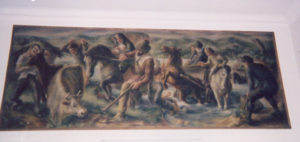
West Haven’s Earliest Days
Part III
See part 1 here.
See part 2 here.
See part 4 here.
See part 5 here.
We acknowledge the efforts of Lorraine Wood Rockefeller, who originally set these words down in about 1960.
A footbridge was built over the West River in 1639 so that they could go to and from the district known as West Farms. In 1640, the colony made the first division of these “common lands” by lot and the following year a cart bridge was built over the West River.
The early settlers had found their way across at low tide for then West River was fordable even well toward the mouth but going back and forth was no easy task.
New Haven colonists first used this land to pasture their cattle. They cut salt hay along the shore and harvested oysters and clams. Chief Anawon’s braves once hunted hunted through this district seeking venison and bear steaks.
The division of lots measuring 160 rods inland from the shorefront varied in proportion to wealth and size of each family.
In 1646 Nehemiah Smith promised to care for all of the town sheep in return for the use of certain west side pasture lands as his own, “where the sheep may have the air of the sea in the summer time.” It was about 1648 before any actual permanent record was made of settlement within the boundaries of the present township. The first dwellings were simple huts for oystermen, fishermen, farmers and herders.
It is known that seven or eight families established permanent homes in 1650 in West Farms. The first structures erected were only cabins, huts or any kind of shelter, but in a few years, substantial homes were built, some standing today. The house on Main Street, owned by Mrs. John K. Stevenson, built in 1684; the Ward-Heitman house built in 1685; the Stevens house on Elm Street, built in 1735; the Captain Clark, T.J. Warner’s on Jones Hill Road, built in the early 18th Century with its double chimney built for a hiding place during the Revolutionary War, and many more early landmarks still stand.
Oysters and sea products gave a fairly satisfactory income in this area. Shells were burned for lime, white fish were used for fertilizer and produced fish oil, codfish were dried and stored for food. Native lumber was used for shipbuilding and there was plenty of pasturage for livestock.
The lands in the Jones Hill Road section were held as commons for pasturage and forage. Veterans of King Philip’s War received special consideration and were granted acreage in proportion to their length of service. Although there are no detailed historical accounts of this period there is evidence that economical planning was used.
To be continued-